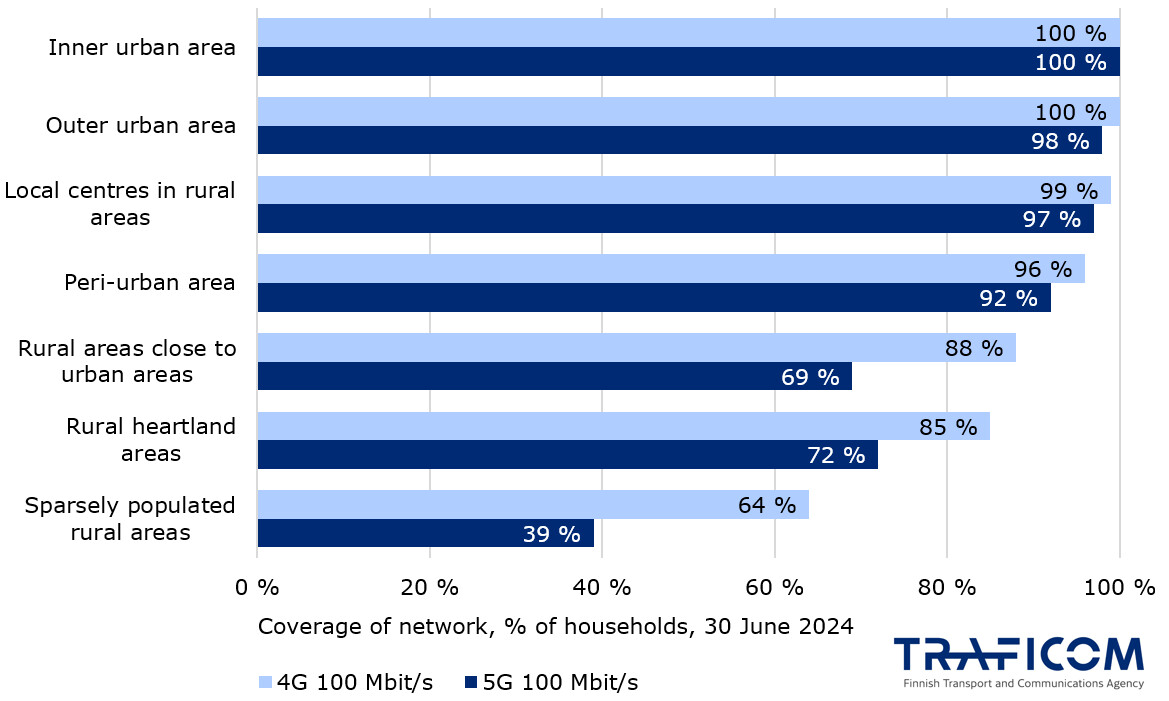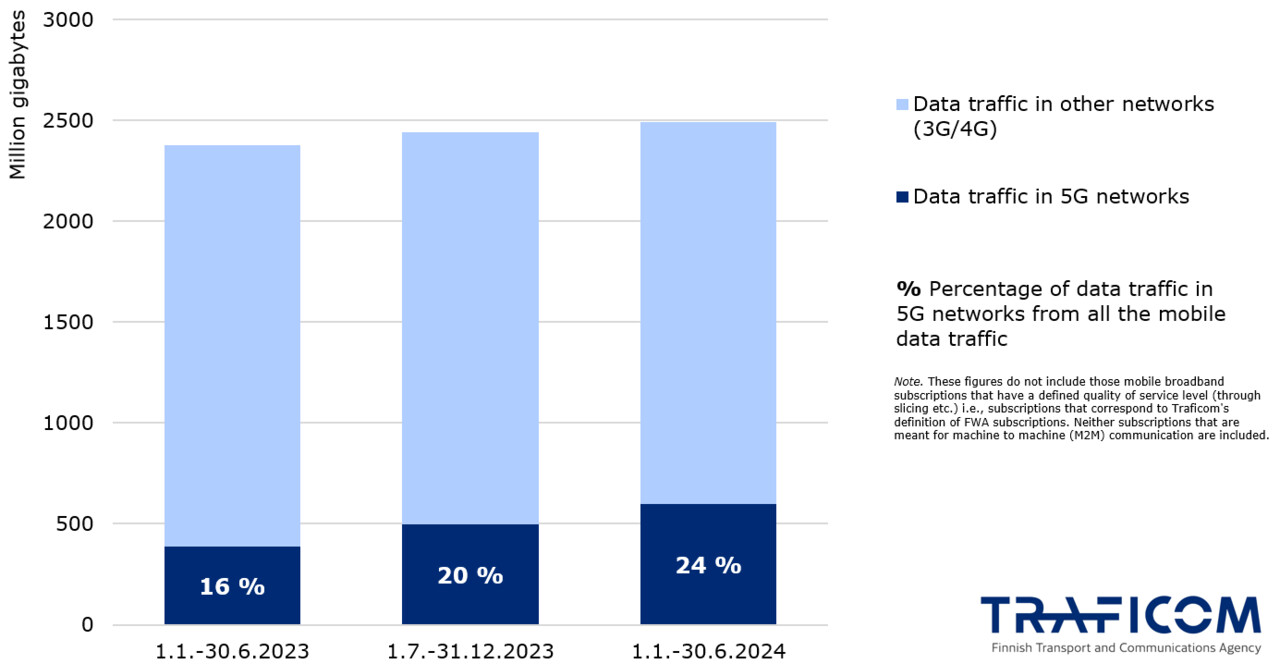According to data collected by the Finnish Transport and Communications Agency Traficom from telecommunications operators, high-speed 4G or 5G mobile networks covered 96% of Finnish households at the end of June 2024. However, there are populated areas outside cities and urban areas that do not have access to high-speed mobile connectivity. More and more 5G networks are being used, 24% of Finland's mobile data transmissions were carried over 5G networks in the spring of this year.
In Finland, 5G networks have been built at a rapid pace since the beginning of the decade. The majority of households are already located inside a high-speed 5G network area. At the end of June 2024, a high-speed 5G network was available for 91% of Finnish households. However, only 16% of the land area was covered by the network. Correspondingly, for the high-speed 4G network, availability was 96% of households and 26% of the land area. “A high-speed network refers to a network that can reach a download speed of at least 100 megabytes under ideal conditions. Such networks are primarily built around population centres, because there is the most use there and thus also the need for additional capacity,” states Senior Specialist Joonas Sotaniemi.
High-speed mobile networks are built especially in population centres
High-speed mobile networks are available in large population centres and their surrounding areas. However, the differences between urban and rural areas remain considerable. 75% of Finns live in urban areas and the situation with mobile networks is good in these areas: almost all households are covered by fast network availability.
In rural areas, there is a lack of a fast mobile network both in populated areas and in their vicinity. The coverage of mobile networks is the weakest in sparsely populated rural areas: only 39% of households are in the high-speed 5G network area, on the other hand, a high-speed 4G network is available for 64% of households. So there are about 50,000 households in sparsely populated rural areas that are outside the high-speed mobile network.

Mobile data to be transferred to 5G networks
In Finland, a lot of mobile data has been consumed when compared internationally, i.e. internet has been used more over mobile networks than in other countries relative to fixed network use. There have been several reasons behind this, from Finland's advanced mobile networks to relatively inexpensive subscriptions with unlimited use.
The growth rate of mobile data transmission seems to have reached its peak in Finland. In the spring of this year, mobile data transmission grew by only 5% compared to the spring of 2023, while in the spring of 2020 it grew by 29% compared to the previous year. Thus, the use of data transfer continues to grow, but not at the same rate as in previous years. These figures include the data transfer use of smartphone and mobile broadband subscriptions. Mobile broadband subscriptions include, for example, subscriptions for 4G/5G modems and subscriptions for tablets and computers, but do not include subscriptions for sale to homes, such as fixed broadband subscriptions and subscriptions with a quality promise.
More and more mobile data is being transferred to 5G networks as networks expand and 5G subscriptions and devices become more common. Three years ago, only about 5% of all data transmissions were carried over 5G networks. In the spring of 2024, 24% of all data transmission for smartphone subscriptions and mobile broadband subscriptions took place over 5G networks. The amount of data transmission on the 5G network had increased by 54% during the past spring compared to the spring one year earlier. Compared to Sweden, for example, 5G networks have built up rapidly in Finland. In Sweden, a faster 5G network was available for 64% of households and 7% of mobile data transmission was carried over 5G networks in 2023.

Animation of the development of the 5G network
Over the years, 5G network growth has been rapid. The coverage of the high-speed 5G network covered 91% of Finnish households at the end of June this year, which is 24% more than at the end of 2020. During the same period, the network coverage of the land area expanded by 14%, being 16% at the end of June this year. However, in recent years the rate of development has slowed down, as the largest population centres have already been covered.
Watch the animation of the development of the 5G network on YouTube. (External link)
Additional information:
In the coverage data, fast connection means a maximum download speed of at least 100 Mbit/s under ideal conditions. Ideal conditions do not take into account, for example, the effects of buildings, natural barriers, the device used or other users on the accessible connection.
Coverage of mobile broadband services (External link)
Mobile subscriptions (External link)
Senior Specialist Joonas Sotaniemi, tel. +358 29 539 0309, joonas.sotaniemi@traficom.fi
Senior Specialist Marja Heinonen tel. +358 29 534 7355, marja.heinonen@traficom.fi